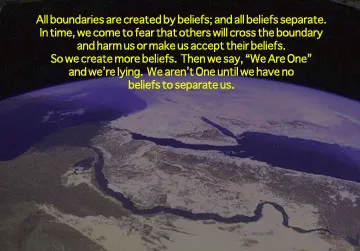We Are One
One of the most dangerous beliefs to come out of the New Age Movement is, “We are One.” It’s hard to understand why this statement is dangerous because it’s true. However, it’s only true at the True Self level. When we put True Self thinking on top of false self beliefs, we create serious level confusion. Our false self usually projects an opponent that we abhor, and we can’t escape them because our false mind thinks we’re one with them.
The last thing we want is oneness with other false selves. If our false self believes in oneness, it will also become one with other people’s confusion, pain, or suffering; or it will take responsibility for things that we didn’t create.
Once we understand that our false selves weren’t designed to be one with other false selves, the process of letting go gets much easier and faster. The false self is like a creative container. In order to create anything, we do need some beliefs. We hold the beliefs we need in our false self container while we create or co-create; then when we’re done with that creative act, we erase the container and start over. This was called remaining a mental virgin in the ancient world.
Beliefs were never meant to be permanent. The True Self holds that which is permanent or immortal; it can’t be erased. Therefore, letting go of the belief in oneness is totally safe; and it can be life changing.
Mind As Computer
The computer is a near perfect analogy for our minds. When we buy a computer, it comes with an operating system. Everyone gets an operating system. You could say that computers are the same at birth. But the operating system doesn’t do much; it only provides creative potential. Likewise, our True Self is our mind’s operating system. It provides the potential, but we need beliefs or programs to create.
Once we take over creative responsibility for our computer, we load programs, many of which we share with other users. These popular programs could be likened to cultural or religious beliefs. If we enjoy a particular program, we’ll want to study it or talk about it with others. We might take classes in that program or join a user’s group. We might not want to ever delete that program, but we can. And, most important, we don’t have the right to sneak into another person’s office and install our program on their computer. We must honor the privacy of others and leave their hard drive alone. Our passion is meant to fuel our own creativity — not to become an evangelist for our programs.
After loading programs, we add data, sound, and images that are uniquely our own. In a short period of time, we won’t find another computer exactly like ours in all the world. We can’t let go of the operating system or True Self because that would destroy our creative capacity. But we have complete control over our hard drive (our false self). We can add or delete programs and data as necessary depending on what we want to create and who we want to co-create with.
Back to The Mind
The data or programs we load into our false mind create uniqueness. If we chose our programs carefully for creative purposes, we’ll love the focus and potential that our false mind provides. We won’t feel separate from others because our True Self has oneness handled. In addition, we’ll easily erase the beliefs when our creative focus changes.
But if we didn’t choose our programs, we’ll lack creative uniqueness. We’ll only be able to copy others. We’ll find it difficult or impossible to erase our hard drive. We’ll fear that erasing the shared programs or data will produce loneliness (when the exact opposite is true). Our perfect creative tool has now become a high security prison where the prisoners make sure that no one escapes.
If we’ve had controlling people in our life who thought they owned our hard drive, we’ll fear the programs (beliefs) of others. We’ll fear that everyone wants to take over our hard drive. When we fear that another can do such a thing, they do. This is a huge problem in the world today. Everyone is afraid of everyone else’s beliefs. They keep trying to strengthen their firewall (boundaries) with more beliefs and programs. They don’t realize that in order to fear another’s belief system, they have to hold it in mind. If we let their beliefs go from our mind, we lose our fear of them. Our immortal True Self provides far better protection than even the best program.
False Self Example
If my friend and I share a belief in hard work, and I delete my belief, her mental container remains unaffected. I can’t delete beliefs from her mind. But now I’m leading an easy life while she’s still working herself to death. She could let go of her belief and join me, but she’s proud of her hard work ethic. She gets approval for her martyrdom. From her veiled perspective, I might look lazy or like I’m cheating at life. I’m now her enemy.
The false self bonds or creates the illusion of oneness using beliefs. It looks for like-minded people for comfort and security. It wants other prisoners around it to validate its false rightness. It feels lonely without like-minded support.
After letting go, we’re often tempted to turn back because those we care about believe we’ve abandoned, rejected or hurt them. But we must keep letting go until we clear our mind completely and rediscover the place where WE REALLY ARE ALL ONE — the place of no borders. We didn’t abandon or reject them; they’re creating their own painful separation by holding on. Once our own mind is free and our judgment gone, we can hold out our hand. And often they reach up, grab on, and let go. Now, WE ARE ONE.
